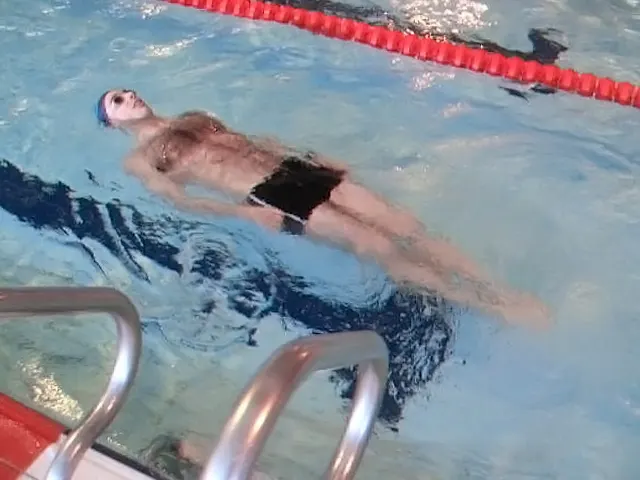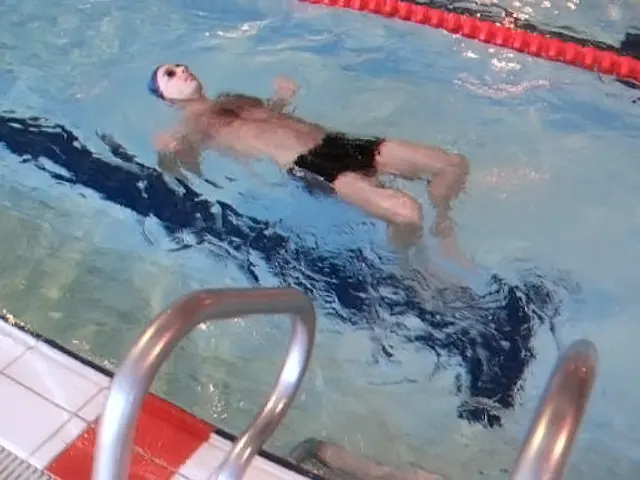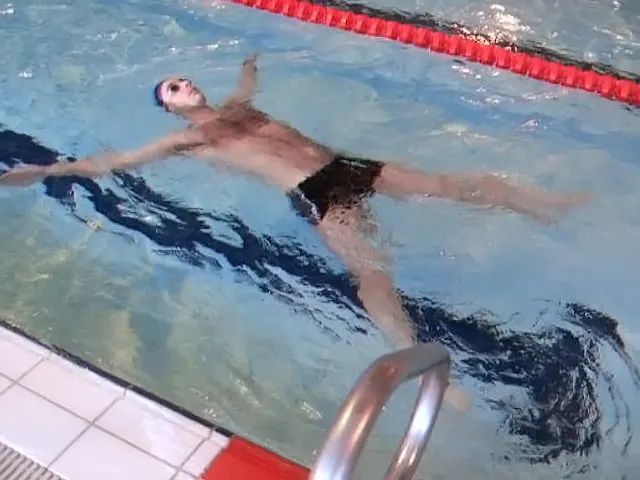The elementary backstroke is a basic swimming technique that is easy to learn and, therefore, useful for improving your water confidence as a beginner.
As its name indicates, it is swum on the back and uses a simple arm stroke in conjunction with a breaststroke kick for propulsion.
Swimming Video
The following video demonstrates elementary backstroke:
Swimming Technique
We will now explain the swimming technique of the elementary backstroke.
Initial Position and Glide Phase
Let’s start with the initial position and glide phase:
1) Turn towards the wall and push yourself off the wall with your feet. Move into a horizontal position on your back.

2) Your head is in a neutral position, in line with your body.
3) Your face is above the water and turned upwards.
4) Your arms rest along your body.
5) Your palms face your body.
6) Your legs are extended and held together.
7) Glide a little before you start with the arm and leg movements.
First Active Phase – Chicken
1) Bend your elbows and draw your hands toward your armpits as if you wanted to tickle yourself.
2) At the same time, bend your knees and bring your feet toward your buttocks. Keep your legs together while you bend your knees.

3) To illustrate this position to children and make it more fun, you can call it chicken or monkey.
Second Active Phase – Eagle
4) Extend your arms sideways so that your body forms an X in the water. Your palms should face backward.
5) Spread your legs while simultaneously extending them.

6) For children, you can call this position eagle or plane.
Third Active Phase – Soldier
Finally, you perform the propulsive movements of this swimming stroke:
7) Move your outstretched arms backward and inward so that they push against the water and return to their starting position at your sides.
8) Simultaneously move your legs together again. This also provides propulsion and brings your legs back to their original position.

9) You can call this position soldier or rocket for children.
Glide for a few moments then start a new stroke cycle.
Breathing
You inhale during the first phase of the swimming stroke, as you draw your arms up to your armpits and your legs up to your buttocks.
You exhale during the next stages of the stroke cycle, as your arms and legs move outward, backward, and inward back to the starting position.
Advantages of Elementary Backstroke
1) It is a swimming stroke that can be swum in a very relaxed way.
2) The elementary backstroke is swum on the back. This makes breathing straightforward as the face is turned upwards and held above the water surface.
Moreover, compared to regular backstroke, projections of water into the face are prevented, as the arms remain underwater.
3) The arm movements are simple, symmetrical, and synchronous and, therefore, easy to learn. Nevertheless, they are very effective.
4) The leg movements are also symmetrical and synchronous and relatively easy to learn. The leg movements are similar to the ones used in the breaststroke kick.
5) Finally, the arm and leg movements are also synchronous and are performed in the same direction.
The arms and legs move forward during the first phase of the stroke, then outward during the second phase, then backward and inward during the third phase of the stroke.
Disadvantages of Elementary Backstroke
1) The elementary backstroke is slower than the regular backstroke.
2) You must have a certain degree of balance in the supine position (on the back) before you can learn this swimming stroke.
3) Since you cannot look forward, it is difficult to swim in a straight line, and you must be careful not to hit the wall or another swimmer.
Additional Tips
1) Practice this stroke in shallow water, where you can quickly regain your feet if you are a novice swimmer.
2) If you are teaching children who cannot reach the bottom of the pool with their feet, you should stay close to them and support their head and back with your hands until they have mastered this swimming technique.
3) As described above, it can make sense for children to call the different swimming phases chicken, eagle, and rocket because they capture well the shape of the desired posture.
4) It can be useful to practice the head-lead supine balance drill before learning elementary backstroke.
5) It can be useful to practice the arm and leg movements on solid ground first.
6) It can be useful to practice the arm and leg movements separately in the water using a pull buoy and a kickboard, respectively.
7) You will be more relaxed if you wear swimming goggles and a nose clip because they keep the water out of your eyes and nose.
8) You can use a swimming noodle to support your back while swimming the elementary backstroke.
Related Pages
You may also be interested in the following articles that cover basic swimming techniques:

Chris
Tuesday 20th of June 2023
I have a torn rotator cuff that am not going to be able to fix for some years. Finding exercises I can still do has been difficult but the side stroke (on one side only) and elementary backstroke are both fine.
Christophe
Wednesday 21st of June 2023
Hi Chris,
Thanks for sharing that insight. And I hope you'll eventually be able to fix your shoulder.
All the best,
Christophe
Stephen Williams
Saturday 5th of March 2022
Over the years I altered this stroke by kicking the feet and at time simply dragging the feet to give the arms more exercise. I’m just getting back in the pool after several years. I’m motivated to swim rather than use machines. I’m curious about how much energy I’m burning doing this stroke. I am up to 1hr 15 min using it. My ruten when I was younger was forward swimming 1/2 lap and emergency backstroke second half of the lap. This time out I have just been doing the this backstroke.
Mary Conton
Thursday 16th of August 2018
Up, out, together and glide. Love the Elementary Backstroke. No pain on my joints.
The breaststroke or the crawl kill my joints.
Hoping to find something on the side stroke. I don't seem to have pain with this stroke either.
Ashleigh
Sunday 22nd of July 2018
This article really helped, thank you!
I love doing this, though I’d forgotten the name.
I have had a bad injury in my left knee, but the damage is not to the point my orthopedist feels knee replacement should be undertaken.
So low impact exercise, yay, I love being in the water.
I was going to do a water aerobics class, but it seemed so slow, that I decided to water walk in a lane. Then got to the deep end and kind of fell into the elementary backstroke.
I only swim the deep end of an indoor Olympic sized pool, but am now doing 25 laps, going by back and forth.
Now I’m ready to move to regular backstroke, but have to get the rolling motion in, to keep water from my face and not wind up with sinus and respiratory junk.
The knee problem is so much better, and overall joy if moving through the water again is beyond description.
Christophe
Monday 23rd of July 2018
Hi Ashleigh,
This is a nice story which brought a smile to my face. I'm glad to hear that swimming is giving you so much joy and improving your health.
Best,
Christophe
Ilia Korboukh Sr.
Sunday 15th of July 2018
Hi Christophe,
My back pain disappears after I do the following stretching in water exercise originated from elementary backstroke.
1) Starting the exercise, I lay in the water on my back with both hands in the cruciform position.
2) I keep my body on the water surface by moving my legs up and down in alternated fashion.
3) Following your suggestion, I also use a water noodle by placing it under my back.
4) From this starting position, I move my hands as far as I can above my head, and maintain such 'surrender' position 2-3 min.
5) Then I return to the starting position and repeat stretching again.
As with all other exercises that I used, the healing effect against back pain is temporary.
Still, this simple exercise in water deserves to be tried.
Christophe
Sunday 15th of July 2018
Hi Ilia,
Sounds interesting. I'll give it a try the next time I'm at the pool.
Thanks,
Christophe